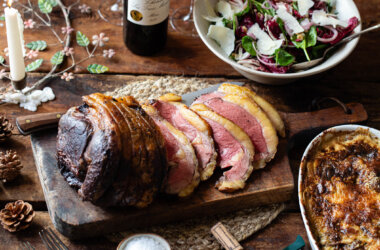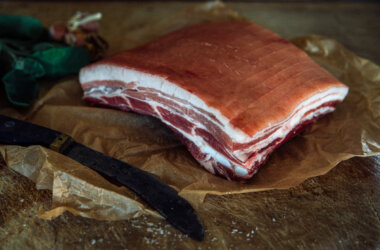
A Cornish pasty is such a good thing. A warm, flaky pocket of comfort and deliciousness. It is reassuring that something so basic can be so delicious. Don’t tell the proud Cornish folk of our digression away from beef, but the venison makes for a tasty variation on the theme. This venison pasty recipe takes inspiration from traditional Cornish pasties but adds a rich venison filling for a delicious twist.
Golden venison pasties like these are a perfect example of how homemade venison pasties can elevate a classic dish. The game meat pasties are hearty, satisfying, and surprisingly easy to make, making this an ideal easy venison pasty recipe.
I find it really rewarding when you set out to make something like this that you’ve had many times before, and it ends up being much more delicious than you ever remember it. This venison shortcrust pasty is exactly that – a delightful alternative to a traditional Cornish pasty that’s perfect for family cooking.
Whether you’re looking for a venison pie alternative or simply want to explore the joys of rich, rustic fillings, this recipe is a great choice for anyone who loves classic, comforting flavours. These pasties are simple to make, and I feel like they would be a fun family activity.
Serves: Makes 4 pasties
Cook time: 4 hours 30 minutes
Ingredients
Pastry
Filling
Method
For the Shortcrust Pastry
- Start by preparing the shortcrust pastry. Place the flour and baking powder into a food processor fitted with a blade attachment and pulse briefly to combine.
- Gradually add the cold, diced butter and lard, a few cubes at a time, while pulsing. Continue until the mixture resembles fine breadcrumbs.
- Slowly pour in the cold water while pulsing, just until the dough starts to come together. Be careful not to overwork the mixture.
- Remove the dough from the food processor, shape it into a large sausage, wrap it tightly in cling film, and refrigerate for at least 3-hours to chill and rest.
For the Filling
- To prepare the filling, cut the venison into smaller pieces since it will cook from raw inside the pasty, as is traditional. Using a sharp knife, divide each piece of venison into 3–4 smaller chunks, then transfer to a large mixing bowl.
- Peel the swede and potatoes, then dice them into roughly 1½ cm cubes. Add the diced vegetables to the bowl with the venison. Season generously with salt and a good amount of black pepper – more than you might usually use, as this will enhance the flavour.
- Preheat your oven to 190°C (fan 170°C).
Assembling and Cooking the Pasties
- Remove the dough from the fridge and divide it into four equal pieces. Working with one piece at a time, roll it out on a floured surface to about the thickness of a pound coin. If unsure, keep it slightly thicker to avoid tearing. Use a plate (approximately 20cm in diameter) as a template to cut out a neat circle.
- Place a generous mound of the filling along the centre of the dough circle, leaving space at the edges for sealing. Sprinkle a little plain flour over the filling and add three small knobs of butter on top.
- Lightly wet the edge of one half of the dough using your finger. Fold the other half over the filling to create a semicircle. Press the edges together, then crimp them neatly all the way around to seal the pasty.
- Place the pasty on a baking tray lined with parchment paper. Use a sharp knife to make a small score in the centre to allow steam to escape. Repeat the process for the remaining pieces of dough and filling, refrigerating each finished pasty as you go.
- Once all the pasties are assembled, brush the tops with whisked egg for a golden finish.
- Cooking: Bake the pasties in the preheated oven at 190°C for 10-minutes. Then reduce the temperature to 170°C and bake for a further 45-minutes, until the pastry is golden brown and crisp.
- Allow the pasties to cool for at least 20-minutes before serving, as the filling will be extremely hot!









